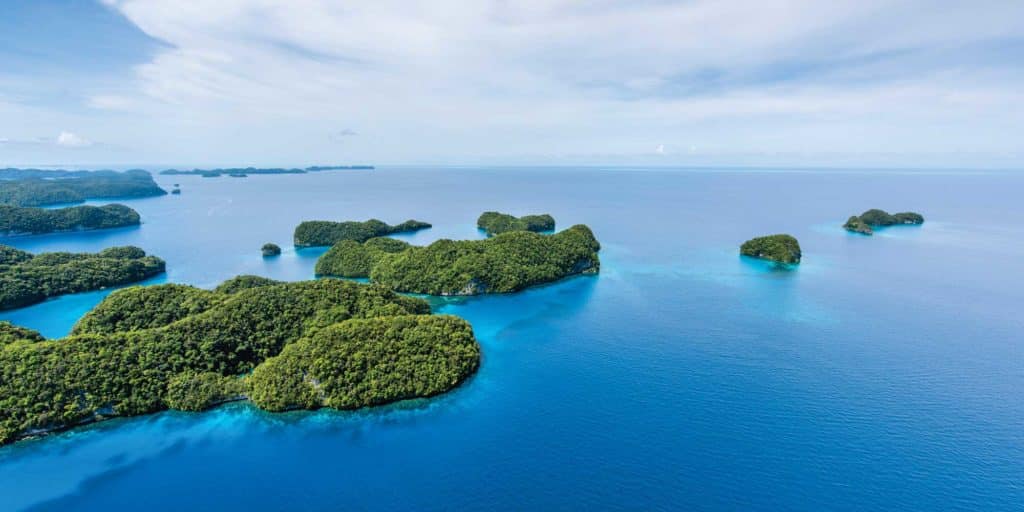
Palau rises, lonely and secluded, out of the vast North Pacific Ocean. Teetering on the edge of Micronesia and Asia, between Guam and the Philippines, it straddles the cultural divide of East and West. For sailors, it’s where rhumb lines converge — a haven for yachts sailing in either direction, a safe place to wait out the storm season before heading on. For us, it was an unexpected paradise.
My partner, Steve, and I arrived outside the reef entrance at midnight, eight hours after we had hoped to be there and far past either of us caring. It had been a long passage, 1,100 nautical miles from Kavieng, Papua New Guinea, and one of our slowest to date aboard Kate, our Newport 41. Mother Nature and good old Neptune had conspired against us the whole way. We battled countercurrents, sailed through the beginnings of a typhoon and had days of windless drifting, all of which saw us celebrate Christmas underway. Now, we had to wait for enough light to navigate the long, narrow passage that would finally allow us to tuck inside the safety of the large lagoon that surrounds Palau.
At dawn, we shook the reef out of the sails and pointed the bow toward land. A pod of dolphins escorted us into shallow waters as bright-white tropic birds swooped and reeled above us. Our spirits rose as the sun crested the horizon, or perhaps it was just the effect of the first cup of coffee I had drunk in almost a month. I was tired, emotionally exhausted by the passage and was looking forward to enjoying the spoils of land — a hot shower, a cold beer and a comfortable bunk. Of course, first there were the formalities.
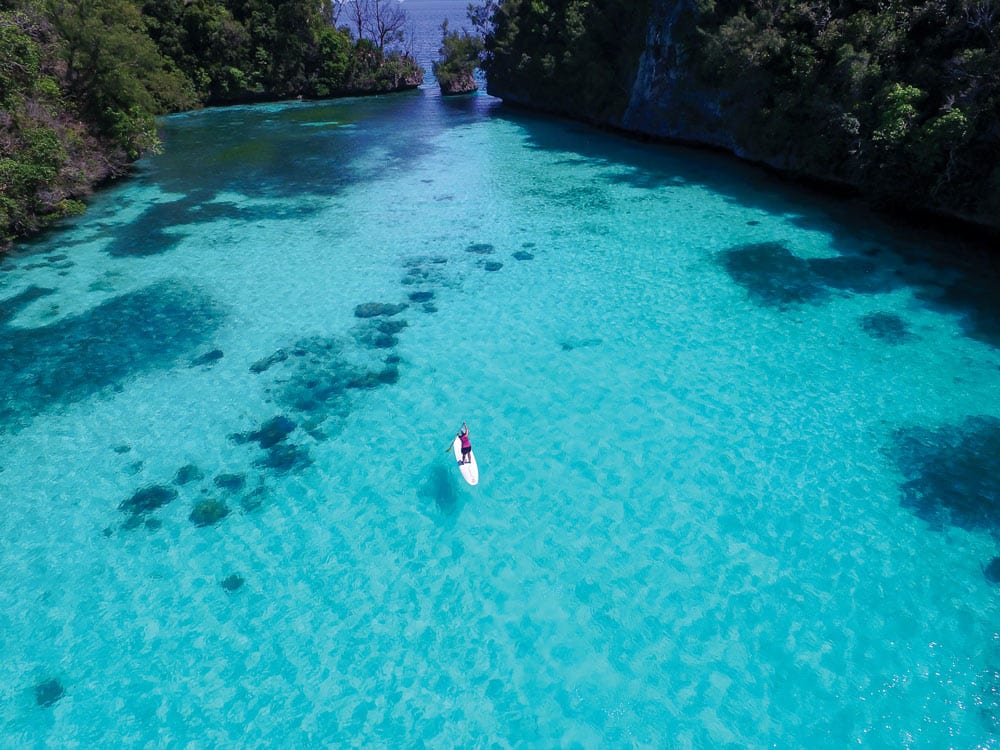
After navigating the busy channel through the reef, we tied up to the large, conspicuous yellow pier in Koror, the main town and port of entry, as is required. While researching clearance procedures for Palau, we had read several complaints about boats being charged linehandling fees when they tied up. Twenty bucks seemed a bit steep for a few moments of work on behalf of the dock workers. Really, $20 sounded like a bit of a scam. Then, however, we approached the pier.
Designed for workhorse steel cargo ships, the dock was a formidable concrete wall with the occasional industrial rubber bumper and huge bollards. When we arrived at low water, there was a dense hedge of oysters exposed and a 5-foot difference between the height of our deck and the wharf. We threw our lines to the men waiting on the dock. They greeted us with smiles, offered a receipt for their services and contacted the officials on our behalf. Within a few moments, the government officials arrived, took copies of our documents, stamped our passports and welcomed us to Palau. The dock was the most difficult part of our clearance procedure, and $20 now seemed like a bargain.
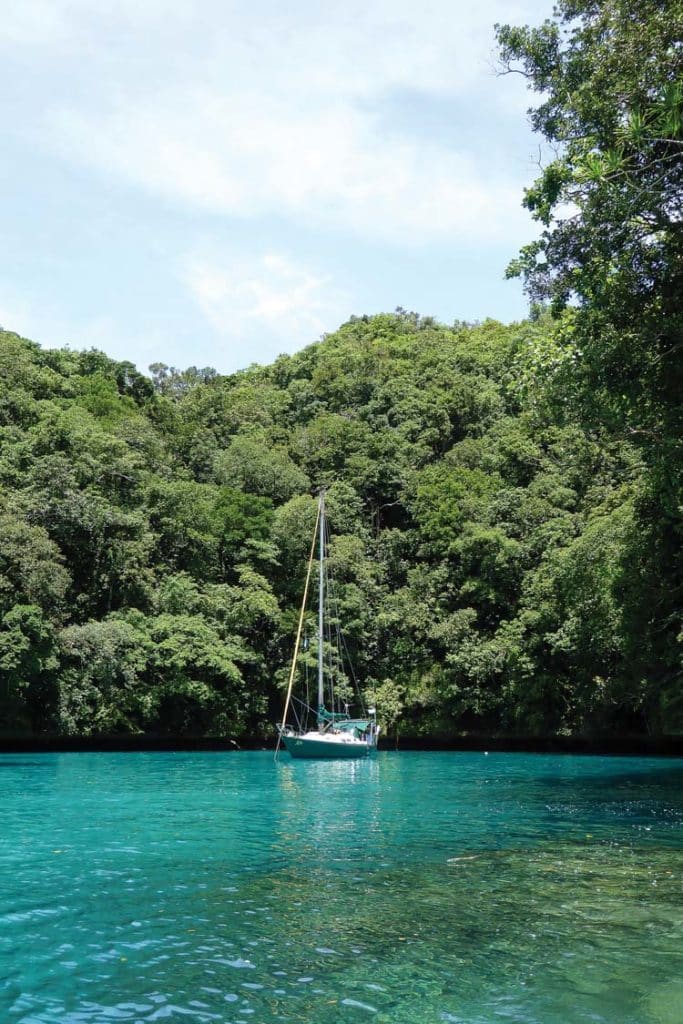
The Royal Belau Yacht Club was a short motor around the headland, and as we picked up our mooring, the bay was busy with tour boats returning for the day and packed full of tourists who flock to Palau for the world-class diving. Steve and I settled in, the relief of arriving finally washing over us, and the familiar siren call was heard loud and clear: It was time for solid land and celebratory refreshments. We unpacked the dinghy and headed ashore.
More of a concept than a physical space, the RBYC is housed under the roof of the well-established and busy dive operation Sam’s Tours. The Bottom Time Bar and Restaurant, the hub of Sam’s Tours/Royal Belau Yacht Club, was a hive of activity, with tourists, locals and yachties all vying for a seat in the open-air establishment. Offering cruisers affordable moorings, a safe dinghy dock, mail service, hot showers, fuel, water and Wi-Fi access, the RBYC is home base to many while in Palau.
We slipped into the busyness of civilization with alarming ease. It was only a short walk along the main road to town, where for the first time in more than a year, we found not one but three American-style supermarkets, shelves full of choices ready to overwhelm. We were amazed at the selection, but also noticed how much excess packaging the Western brands use — four six-pack rings in every case of beer, cardboard boxes suffocated in plastic wrap, meats sold on Styrofoam trays. With no municipal recycling plan, it all ended up in the landfill, a heap we could see, and smell, on the way into town. After a week or so back in civilization, we were craving deserted anchorages and picturesque surroundings. Thankfully, the Rock Islands, just a few miles south of town, were well stocked with both.
The uninhabited Rock Islands are a string of almost 300 oddly shaped limestone islands scattered across 18 square miles of protected lagoon. The area has been conserved as a national park and was named a UNESCO World Heritage Site in 2012. Imposing, monolithic stone arches protrude dramatically from the sea as tiny islets fringed with tropical foliage stand fragile and silent. Steep cliffs, pocked with caves, weave through a maze of bays that provide a seemingly endless choice of sheltered anchorages. It was the perfect place to escape.
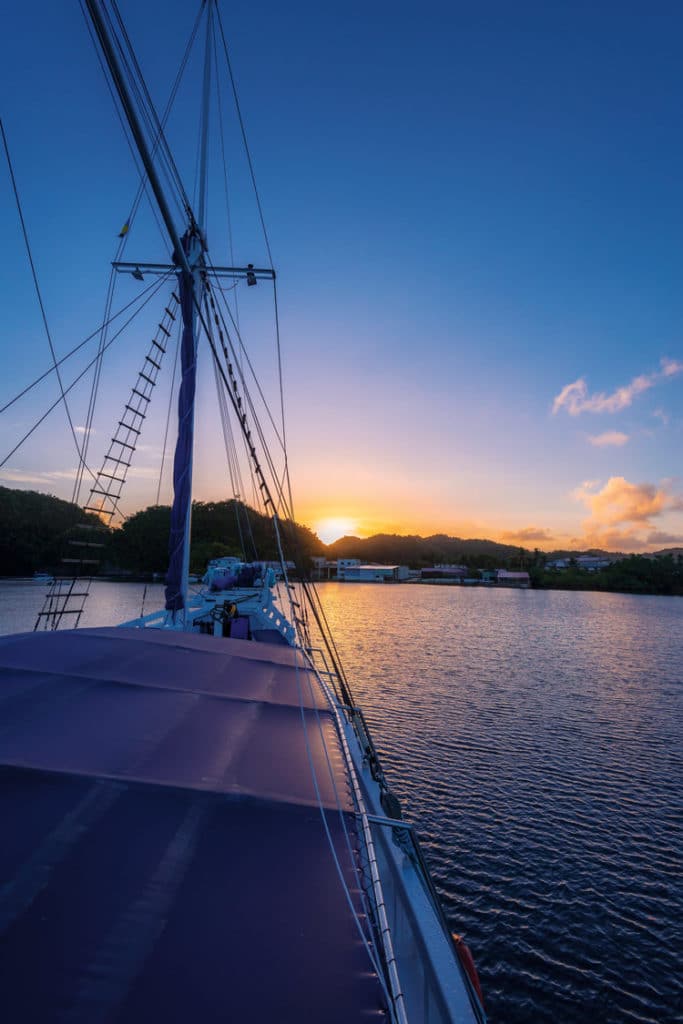
Dawn in blue at Rock islands,Palau
However, a visit to the Rock Islands comes at a price; the 10-day visitors permit costs $50 per person. Then there is the required cruising permit for your boat, which is calculated using the LOA. For us, it was $40. If you plan on fishing, each person must buy a $20 fishing permit. Of course, these are additional to the general clearance fee, visa and cruising permit that are paid upon arrival. For many cruisers, the thought of paying such charges is crazy, but I wouldn’t recommend trying to circumvent the system in Palau. The rangers do daily patrols through the outer islands, and although you might not be approached or spoken to, you can bet that your boat, and presence, has been noted.
In anchorages closer to the cordoned-off snorkeling spots and dive sites, our day would be disturbed by the dozens of tour boats that zoomed about the area. While giving the day tourists a thrill ride through the island chain, the tour boats kicked up a constant chop and had little respect for our boat, our dinghy or us. On a few occasions, a tour-boat driver came dangerously close at top speed, and showed little remorse in doing so. But, since there are no accommodations in the Rock Islands, by 5 o’clock, the tourists were safely back in Koror and our pristine anchorage was quiet once again. It was also easy to find an out-of-the-way anchorage and avoid the daily swarms altogether. Since the islands are uninhabited, we came well-prepared for our stay, as there is no place to stock up or refresh essentials, such as beer or gasoline.
Palau is famed for its diving but offered just as much for the casual snorkeler. Although there are several marked snorkeling sites on the chart, I often found enough to amuse and interest me right in our anchorage. Vibrant coral reefs hosted a variety of hard and soft corals, many of which I had never seen before. We encountered several colorful giant clams and enjoyed watching the feather stars and sea fans that congregated in the swift-moving waters in the passes. Everywhere we went, we spotted turtles, mostly hawksbills, the local population healthy and inquisitive.
The Rock Islands not only provide comfortable anchorages, they are also perfect for anyone who enjoys kayaking or stand-up paddleboarding. With miles of protected coves and waterways, it is an ideal place for beginner paddlers such as myself; you can concentrate on staying on the board without worrying about wind, waves or oncoming traffic. For the more advanced who crave a little adventure, the limestone islands are full of arches and narrow passageways that reveal themselves as the tide turns.
The tall, steep-to islands that protect the area from howling winds also shade the anchorage from the bite of the afternoon sun. This was great for sitting in the cockpit, but had a noticeable impact on the output of our solar panels. The few hours we spent moving the boat from one anchorage to another each day were a welcome way to boost the batteries and keep up with power demands.
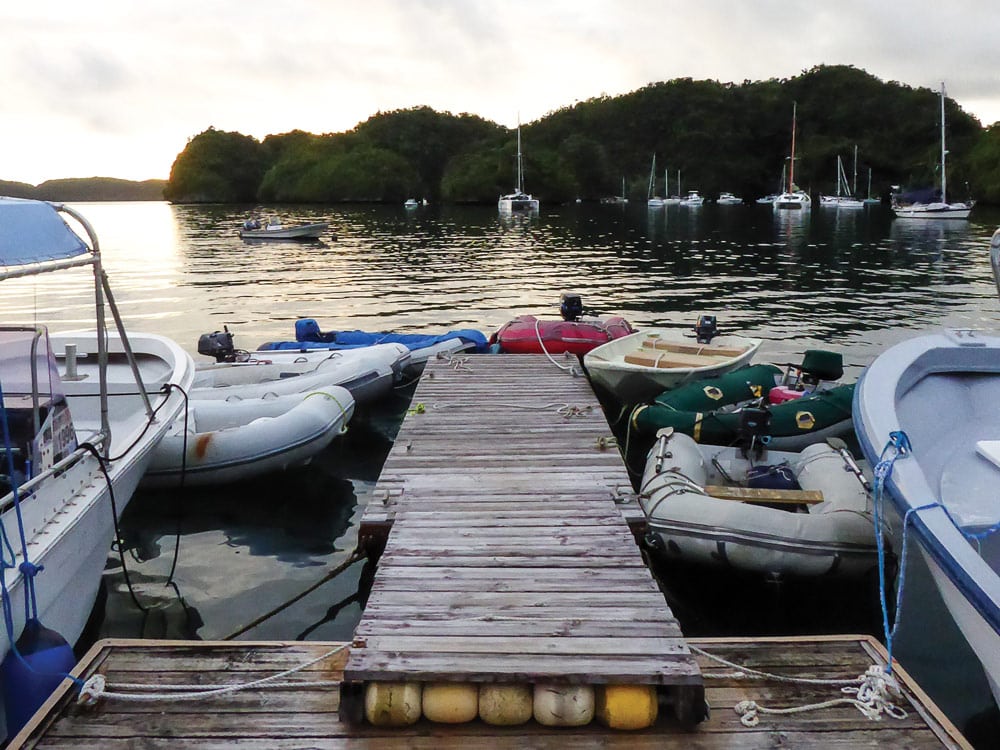
Our days distilled into an easy rhythm: a little boat business in the morning, then out to explore the islands by dinghy. One of the main attractions for us was the hidden network of caves. Etched into the limestone cliffs, we found a collection of crevasses, some big enough to climb into, others large enough to drive the dinghy into. Steve and I will often make a fire and cook a meal ashore on a beach, but not here. Beaches in Palau are in short supply, and there is a ban on open fires in all national park areas. So, instead of a hot meal on the sand we often packed a picnic lunch to enjoy in our “cave du jour.”
Some of these caves also held secrets from the past. Palau was host to one of the bloodiest battles in the Pacific in World War II, and although we did not venture to the southern island of Peleliu, where most of the action took place, we found constant reminders as we explored. Abandoned anti-aircraft guns still hide in the cliffs, as do covert lookout posts, but when we discovered “fuel-drum cave” I couldn’t help myself, I had to get a closer look.
RELATED: Pacific Passage Planning
As I scrambled ashore, a strange uneasiness washed over me. The ground was soft and sticky in places, and in the air hung a heavy, musty basement smell of damp earth and rot. The bright sunlight was swallowed by the cathedral-like interior. It took a few moments for my eyes to adjust, then, before me in the cave were hundreds of fuel drums, empty and rusting, still in the same orderly arrangement they had been put in some 70 years before. They stood, row upon row, like soldiers waiting for a command, frozen in time, fragile and broken.
The space was solemn, and I was so moved by it that I felt compelled to photograph it. Walking about the cave, I was careful not to disturb the fuel drums, not to unsettle the memories. Listening to the rhythmic whirl, click on my old Leica camera, I wondered how many hands had touched these barrels, how many men had stood in this cave, and how many returned home to tell of it. Later that evening, as we sat in the cockpit watching the sunset splash across the sky, I wondered how many people had even heard of Palau and the great sacrifice made by so many.
We toured the Rock Islands three times, despite the heavy park fees. Such was the allure of the quiet solitude that we found throughout the islands. Except for sharing an anchorage for a night or two with another boat, we spent our time alone, surrounded by the austere beauty of the landscape. We would have stayed longer, and envied those American sailors who could, but we had come to the end of our allowed visa extensions. We readied the boat to sail west to the Philippines.
After collecting our last parcel at the post office, we made an appointment with the authorities for departure clearance. The following morning, we went ashore, prepared to pay our final service charge, a $50-per-head green tax. We hoped that our rather generous investment in this small, somewhat overlooked island nation over the past three months would be put to good use. Palau was the respite we needed after such a difficult passage to get there, but it was also so much more.
Heather Francis is originally from Nova Scotia, Canada. She and her husband, Steve, bought Kate, a Newport 41, in 2008.
Palau Details
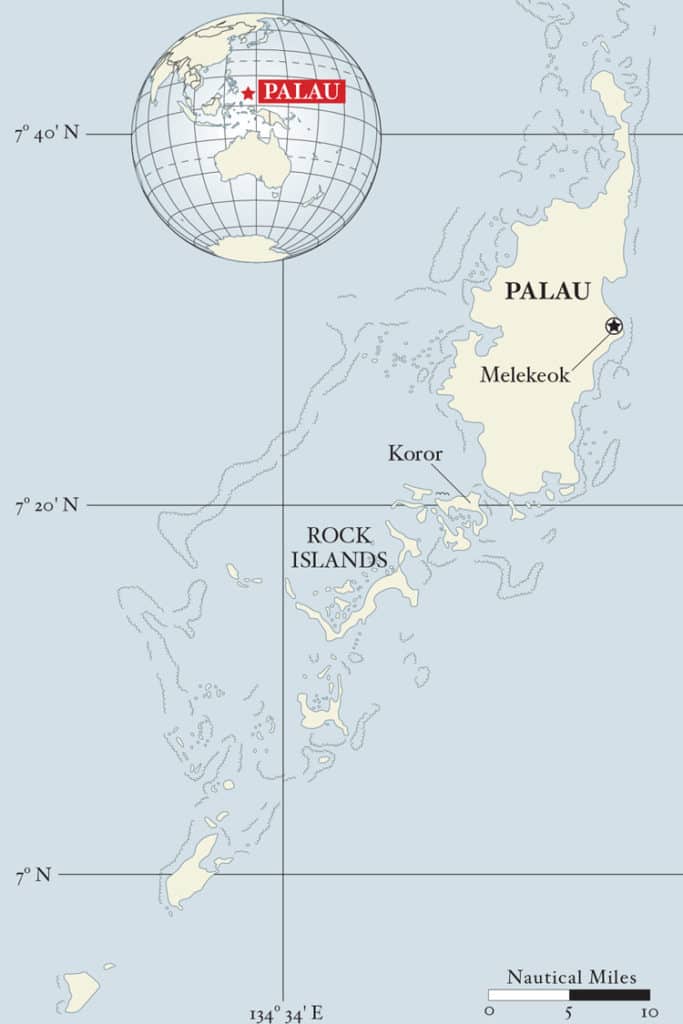
Palau gained independence from the United States in 1994, although it retains free association. As such, U.S. citizens are given a year entry to Palau, free of charge. After three months, they can apply for a temporary resident permit, also free of charge, waiving all national park fees, making the trip to Rock Islands free as well. (Steve and I are citizens of Australia and Canada, respectively, so the fees we paid were different from what U.S. citizens pay.)
Palau has a U.S. zip code, so shipping is cheap and usually speedy, making this a great place to order boat parts and spares from the mainland.
For larger freight from the United States, we found Triple B Shipping to be an immense help. It has offices in Los Angeles, Guam and Palau, and shipments arrive every four to six weeks. It will take care of all your paperwork, including customs clearance when your item arrives.
Cruising Guide to Palau, by Randy Abernathy, is a well-researched and extensive guide to Palau and the Rock Islands. It’s only available as a hard copy, and can be ordered from Amazon. Think ahead and ship to the Royal Belau Yacht Club so that it will be there upon your arrival!
As in many places, the name Palau is the Anglicized version used by the colonial settlers who ran the islands for several decades. However, the traditional spelling and pronunciation, “Balau,” is seeing a revival. It can be confusing because both are commonly used and accepted in everyday business.








